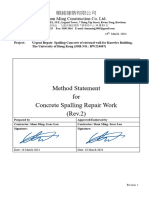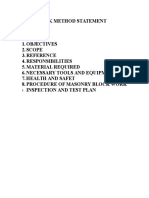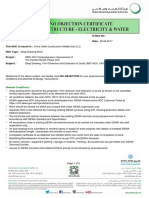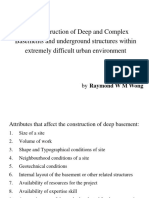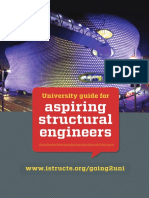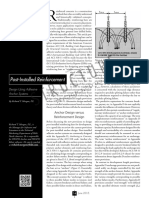Basement Construction Methodology RBK C
Basement Construction Methodology RBK C
Uploaded by
kyleCopyright:
Available Formats
Basement Construction Methodology RBK C
Basement Construction Methodology RBK C
Uploaded by
kyleOriginal Description:
Original Title
Copyright
Available Formats
Share this document
Did you find this document useful?
Is this content inappropriate?
Copyright:
Available Formats
Basement Construction Methodology RBK C
Basement Construction Methodology RBK C
Uploaded by
kyleCopyright:
Available Formats
West Brompton Village
Detailed Planning Application
Royal Borough of Kensington & Chelsea
Basement Construction Methodology
November 2013
Prepared for EC Properties Ltd
by ARUP
Memorandum
To EC Properties Ltd Date
November 2013
Copies Reference number
125066
From Ove Arup & Partners Limited File reference
60
Subject West Brompton Village RBKC Basement Construction Memo
1 Introduction
Ove Arup & Partners Limited (Arup) has been commissioned by Capco to provide structural and
geotechnical engineering advice for the Proposed Development known as West Brompton Village.
This memo provides a high level review of proposed works within the Royal Borough of
Kensington & Chelsea (RBKC) and potential impacts of development on adjacent structures. This
memo is not intended to satisfy the requirement for a Basement Construction Method Statement, as
required by RBKC Core Strategy 2010, but it is expected that such a document could be produced
once the design has been further developed (should it be required). This memo does demonstrate,
however, that it should be possible for the development to take place without detrimental affect to
neighbouring structures.
2 The Site
2.1 Site Location and Description
The RBKC part of the site is located at 348 to 350 Old Brompton Road, London and also comprises
a large area of hardstanding currently used as an access to Earls Court Exhibition Centre. The area
to which this memo relates forms part of the larger site which makes up the Masterplan for the
development of Earls Court, approved in outline by RBKC and the London Borough of
Hammersmith and Fulham (LBHF) in November 2013. It also comprises properties which were not
included in the Masterplan. The reason for the application is to revise the design of this part of the
Masterplan to create a new and improved public entrance into the wider re-development site.
The portion of the site which lies within the RBKC boundary comprises two existing brick
buildings and the apron to Earls Court Exhibition Centre. Both of the existing buildings are
understood to be of brick construction and contain a single level of basement. This is supported by
information from previous planning applications.
A recent aerial view of the site (as taken from Google Earth) is illustrated as Figure 2.1. This shows
the site to be bounded by a disused pub to the east, residential housing to the north, an overland
railway to the west, and Old Brompton Road to the south. Further to this, running tunnels of the
District Line are known to pass under the Earls Court apron.
Y:\JOBS\120000\125000\125066 - PROJECT ECHO\5 EXTERNAL DATA\01 INCOMING DOCUMENT REGISTER\ARUP GEOTECHNICS\131127 WBV BASEMENTS\OUTLINE CMA FOR
WBV.DOCX
Arup | F0.3 Page 1 of 6
Memorandum
Figure 2.1 Aerial View of Site
2.2 Site History
A brief summary of the development history of the site and immediate surrounding area is
summarised as follows:
A review of historical OS mapping indicates the two existing site buildings and nearby
residential properties to have been constructed by 1869 (the date of the earliest available
survey).
Earls Court Exhibition Centre is understood to have been constructed sometime around 1935.
The disused pub situated to the immediate east of the site is first shown on OS mapping dated
1970.
Y:\JOBS\120000\125000\125066 - PROJECT ECHO\5 EXTERNAL DATA\01 INCOMING DOCUMENT REGISTER\ARUP GEOTECHNICS\131127 WBV BASEMENTS\OUTLINE CMA FOR
WBV.DOCX
Arup | F0.3 Page 2 of 6
Memorandum
3 Proposed Development
The Proposed Development shall include the demolition of existing brick buildings at the site and
the subsequent construction of two new townhouses and a combined residential and retail building.
Each of the new buildings is to contain a single level of basement. The residential/retail building
basement shall extend slightly deeper than the townhouses, as this basement will house vibration
isolation bearings. The townhouses will require a further undercroft below the lowest level of
occupied basement to house the vibration isolation bearings.
As outlined in Section 2.1, it is assumed that the residential building to the north of the site and the
disused pub each contain a single level of basement.
A graphical illustration of the Proposed Development is presented as Figures 3.1 to 3.3. For full
details of the scheme, reference should be made to the supporting Design and Access Statement.
A B
Figure 3.1 Extract of West Brompton Square Basement Floor Plan
Y:\JOBS\120000\125000\125066 - PROJECT ECHO\5 EXTERNAL DATA\01 INCOMING DOCUMENT REGISTER\ARUP GEOTECHNICS\131127 WBV BASEMENTS\OUTLINE CMA FOR
WBV.DOCX
Arup | F0.3 Page 3 of 6
Memorandum
Figure 3.2 Cross Section A-A
Figure 3.3 Cross Section B-B
4 Ground Conditions
Sheet 270 of the British Geological Survey (England & Wales, Solid & Drift Edition) indicates the
site to be underlain by Kempton Park Gravels and London Clay. Although a ground investigation
has not yet been undertaken, it is assumed that the full depth of basement excavation shall be within
granular deposits.
It is assumed that the District Line tunnels have had a draining effect on the surrounding
hydrogeology and, on this basis, groundwater is situated below proposed basement level.
Y:\JOBS\120000\125000\125066 - PROJECT ECHO\5 EXTERNAL DATA\01 INCOMING DOCUMENT REGISTER\ARUP GEOTECHNICS\131127 WBV BASEMENTS\OUTLINE CMA FOR
WBV.DOCX
Arup | F0.3 Page 4 of 6
Memorandum
5 Outline Construction Sequence
The envisaged construction sequence is as follows and is representative of typical construction
practice in the London area:
Phase 1 Demolition of existing site buildings
Phase 2 Installation of embedded retaining wall along perimeter of proposed structures. The
retaining wall could be constructed using either sheet piles, contiguous piles, or
secant piles and would likely extend through the locally occurring Kempton Park
Gravels and into the underlying London Clay.
Phase 3 Excavation to underside of basement slab level and construction of raft foundation. It
is envisaged that temporary support (in the form of earthen berms and inclined
propping) will be required to control horizontal wall deflection and vertical
displacement of adjacent structures.
Phase 4 Construction of ground floor slab and removal of temporary propping.
Phase 5 Construction of superstructure.
6 Anticipated Impacts of Development
Provided that the embedded retaining wall and associated temporary propping are designed in
accordance with best practice and due consideration of loading from adjacent structures, the
Proposed Development should have minimal impact on adjacent structures. By extension, those
residential properties which are not directly adjacent to the Proposed Development will likewise
remain unaffected.
Y:\JOBS\120000\125000\125066 - PROJECT ECHO\5 EXTERNAL DATA\01 INCOMING DOCUMENT REGISTER\ARUP GEOTECHNICS\131127 WBV BASEMENTS\OUTLINE CMA FOR
WBV.DOCX
Arup | F0.3 Page 5 of 6
Memorandum
7 Recommendations and Conclusions
Recommendations for further works are summarised as follows:
A ground investigation should be undertaken to inform the design of the proposed development.
These works would need to provide sufficient information on site stratigraphy, characteristic
soil parameters, shallow groundwater level, and details of foundations to adjacent structures.
The proposed basement structure shall be design in accordance with best practice and due
consideration of loading from adjacent structures. This will need to include an assessment of
propping actions to control wall deflections and settlement of adjacent properties during the
basement excavation process.
Following completion of the retaining wall design, a Basement Construction Method Statement
could be completed. This document would need to be prepared by a Chartered Civil Engineer
and will need to demonstrate that the proposed development will have minimal impact to
adjacent buildings, structures, tunnels, services, trees, slopes, surface water, and hydrogeology.
The basement at the Proposed Development is considered to be feasible, is able to be undertaken by
established construction methodology, and is unlikely to cause significant impact to adjacent
structures.
Y:\JOBS\120000\125000\125066 - PROJECT ECHO\5 EXTERNAL DATA\01 INCOMING DOCUMENT REGISTER\ARUP GEOTECHNICS\131127 WBV BASEMENTS\OUTLINE CMA FOR
WBV.DOCX
Arup | F0.3 Page 6 of 6
You might also like
- Mastercode Cost Code System: Quickbooks Pro ManualDocument13 pagesMastercode Cost Code System: Quickbooks Pro ManualMahesh JayawardanaNo ratings yet
- BCA - A Guidebook To The Changes in Building Control 2007-2008Document130 pagesBCA - A Guidebook To The Changes in Building Control 2007-2008lwin_oo2435No ratings yet
- Towers Work Inputs PDFDocument9 pagesTowers Work Inputs PDFMalik AtikNo ratings yet
- DraughtmanshipDocument39 pagesDraughtmanshiphanihusainiNo ratings yet
- BasementDocument10 pagesBasementNikita ShethNo ratings yet
- Building Report Hollow Core SlabDocument13 pagesBuilding Report Hollow Core SlabAhmad OmarNo ratings yet
- Core Wall Survey Control System For High Rise BuildingsDocument12 pagesCore Wall Survey Control System For High Rise BuildingsBos CosminNo ratings yet
- Shear Wall Rigidity AnalysisDocument3 pagesShear Wall Rigidity AnalysisSoumya Gorai100% (2)
- Defect List For Refurbishment Works To Link WalkwayDocument8 pagesDefect List For Refurbishment Works To Link WalkwaysyahidatulNo ratings yet
- 04 - Sanjana Bhandiwad - Assignment 3 - Methods of Construction of BasementDocument45 pages04 - Sanjana Bhandiwad - Assignment 3 - Methods of Construction of Basement04BHANDIWAD SANJANANo ratings yet
- Painting and FRP System For CP4E Link Bridge RevA - HPTDocument81 pagesPainting and FRP System For CP4E Link Bridge RevA - HPTChan Kin CheungNo ratings yet
- Joints in Concrete Pavement Technical PaperDocument22 pagesJoints in Concrete Pavement Technical Paperphyo_thar_1100% (1)
- BuildingnCODE NTDocument89 pagesBuildingnCODE NTAnil PyakurelNo ratings yet
- Technical Specifications January 2019Document7 pagesTechnical Specifications January 2019Sone Aung PyaeNo ratings yet
- Reinforced Concrete Slabs PRDocument54 pagesReinforced Concrete Slabs PRVikki SNo ratings yet
- Reducing Time High Rise Building - ThesisDocument54 pagesReducing Time High Rise Building - ThesisYoseph BirruNo ratings yet
- J-31822 (R2-F) Method Statement of Spalling Concrete - 20240318Document27 pagesJ-31822 (R2-F) Method Statement of Spalling Concrete - 20240318issaclau.shunmingNo ratings yet
- Lecture 1Document72 pagesLecture 1Engr.Muhammad TufailNo ratings yet
- MS005 Block WorkDocument5 pagesMS005 Block WorkMhando Ignas100% (1)
- 3327-Preconstruction InformationDocument12 pages3327-Preconstruction InformationKURONo ratings yet
- Mezzanine Floors Baseplate DesignDocument3 pagesMezzanine Floors Baseplate DesignLlonsson100% (1)
- A1-10 Curtain WallsDocument19 pagesA1-10 Curtain Wallslwin_oo2435No ratings yet
- PT Beam 28m SpanDocument14 pagesPT Beam 28m SpanDicky DjayadiNo ratings yet
- Precast Concrete Cores in High Rise BuildingsDocument118 pagesPrecast Concrete Cores in High Rise BuildingsBarrasons Engineers TeamNo ratings yet
- DHA Construction Development Regulations 2014Document48 pagesDHA Construction Development Regulations 2014Sara TahirNo ratings yet
- Aluminum FormworkDocument80 pagesAluminum FormworkWall-Ties & Forms, Inc.No ratings yet
- Dewa Noc LetterDocument5 pagesDewa Noc LetterSenthilnathan NagarajanNo ratings yet
- ConRepair 04 JurcemNonshirk GP Ed01Document2 pagesConRepair 04 JurcemNonshirk GP Ed01Tuntun Tat0% (1)
- Knauf ENBS Ceiling ManualDocument16 pagesKnauf ENBS Ceiling Manualjini0% (1)
- Notes On Hy-RibDocument20 pagesNotes On Hy-RibMohd Faizal100% (1)
- Conquas Checklist - Kitchen CabinetDocument5 pagesConquas Checklist - Kitchen Cabinetapi-628196609No ratings yet
- Pitzl - Design Manual Connectors - HVP Connectors, SPP ConnectorsDocument32 pagesPitzl - Design Manual Connectors - HVP Connectors, SPP ConnectorsStefan IonitaNo ratings yet
- ICC Tender Doc 1Document159 pagesICC Tender Doc 1charler kinyuajNo ratings yet
- Repair and Retrofit TechniquesDocument93 pagesRepair and Retrofit TechniquesAndreea CălinNo ratings yet
- 461 Dean Studio Floor PlansDocument3 pages461 Dean Studio Floor PlansNorman Oder100% (1)
- Design and construction of deep basements including cut-and-cover structures(拖移項目) 2Document2 pagesDesign and construction of deep basements including cut-and-cover structures(拖移項目) 2Bulooo Mister100% (1)
- Lo 2 - DemolitionDocument29 pagesLo 2 - DemolitionEng Stephen ArendeNo ratings yet
- SECTION 02 4116 Structure Demolition (Actual Requirements)Document2 pagesSECTION 02 4116 Structure Demolition (Actual Requirements)Joice Chiø VelascoNo ratings yet
- PPVC Manufacturer Accreditation Scheme: Application FormDocument13 pagesPPVC Manufacturer Accreditation Scheme: Application FormNicky LimNo ratings yet
- Structural Specification PDFDocument71 pagesStructural Specification PDFgk80823No ratings yet
- 5 Construction Method Statement: 5.1 General DescriptionDocument12 pages5 Construction Method Statement: 5.1 General DescriptionUpali Karunarathne100% (1)
- CIS 13 Public Comment 10.11.2021Document53 pagesCIS 13 Public Comment 10.11.2021nestroyersNo ratings yet
- Inspection Request Form For Beam Launching WorkDocument2 pagesInspection Request Form For Beam Launching WorkWr ArNo ratings yet
- Pnap 071Document14 pagesPnap 071Cheung LeeNo ratings yet
- BLD 305 Design and DetailingDocument61 pagesBLD 305 Design and DetailingJoshua AbubakarNo ratings yet
- PPVCDocument1 pagePPVClow Yi JunNo ratings yet
- Handling - Transportation and ErectionDocument22 pagesHandling - Transportation and Erectionedward the iiiNo ratings yet
- Blackburn Preschool - 2014 Building Condition AuditDocument46 pagesBlackburn Preschool - 2014 Building Condition AuditJon WillingNo ratings yet
- IR Driven PilingDocument2 pagesIR Driven PilingWr Ar100% (1)
- Creep Shrinkage PDFDocument18 pagesCreep Shrinkage PDFmanuelesteNo ratings yet
- 05 Service Duct DetailsDocument1 page05 Service Duct DetailssolebNo ratings yet
- 12SEAGC1996 Site Stabilisation and Foundations For A High-Rise Building On A Steep Slope (Genting Highlands, Malaysia), 1996, Malaysia PDFDocument8 pages12SEAGC1996 Site Stabilisation and Foundations For A High-Rise Building On A Steep Slope (Genting Highlands, Malaysia), 1996, Malaysia PDFfreezefreezeNo ratings yet
- 1997 UBC Earthquake Design - Base ShearDocument7 pages1997 UBC Earthquake Design - Base ShearRamil Decena LaforteNo ratings yet
- CCPU-Monthly Progress Report No.013Document42 pagesCCPU-Monthly Progress Report No.013Nhoek RenNo ratings yet
- Materials and Workmanship: The Building Regulations 2010Document22 pagesMaterials and Workmanship: The Building Regulations 2010Logan GracieuseNo ratings yet
- Design and Analytical ProjectsDocument5 pagesDesign and Analytical ProjectsVishnu Vardhan MekalaNo ratings yet
- MS Basement Slab Casting (Completed)Document72 pagesMS Basement Slab Casting (Completed)Hafiz Kamarudin100% (2)
- A Catalogue of Details on Pre-Contract Schedules: Surgical Eye Centre of Excellence - KathFrom EverandA Catalogue of Details on Pre-Contract Schedules: Surgical Eye Centre of Excellence - KathNo ratings yet
- Some Mooted Questions in Reinforced Concrete Design American Society of Civil Engineers, Transactions, Paper No. 1169, Volume LXX, Dec. 1910From EverandSome Mooted Questions in Reinforced Concrete Design American Society of Civil Engineers, Transactions, Paper No. 1169, Volume LXX, Dec. 1910No ratings yet
- 2nd Oct Thalawakele ReportDocument7 pages2nd Oct Thalawakele Reportchandra BandaraNo ratings yet
- Ground Stabilization: Injetting Cement Grouting Using Pump and Injetion PipeDocument3 pagesGround Stabilization: Injetting Cement Grouting Using Pump and Injetion PipekyleNo ratings yet
- Ground Stabilization: Injetting Cement Grouting Using Pump and Injetion PipeDocument2 pagesGround Stabilization: Injetting Cement Grouting Using Pump and Injetion PipekyleNo ratings yet
- Commonality Found in Recent Basement Projects (Cont.)Document5 pagesCommonality Found in Recent Basement Projects (Cont.)kyleNo ratings yet
- Istruce DubaiDocument2 pagesIstruce DubaikyleNo ratings yet
- Other Considerations When Doing Basement WorksDocument5 pagesOther Considerations When Doing Basement WorkskyleNo ratings yet
- Other Considerations When Doing Basement WorksDocument5 pagesOther Considerations When Doing Basement WorkskyleNo ratings yet
- Basement Project in Very Congested Urban Environment - The Redevelopment of Kwong On Bank in Queen's Road Central, Central District, Hong KongDocument5 pagesBasement Project in Very Congested Urban Environment - The Redevelopment of Kwong On Bank in Queen's Road Central, Central District, Hong KongkyleNo ratings yet
- Complicated Surrounding Environment As Seen in The TST East Station - Underpinning To A Section of Pedestrian SubwayDocument5 pagesComplicated Surrounding Environment As Seen in The TST East Station - Underpinning To A Section of Pedestrian SubwaykyleNo ratings yet
- The Construction of Deep and Complex Basements and Underground Structures Within Extremely Difficult Urban EnvironmentDocument5 pagesThe Construction of Deep and Complex Basements and Underground Structures Within Extremely Difficult Urban EnvironmentkyleNo ratings yet
- Seismic Behaviour of RC Exterior Wide Beam-Column Joints: S.H. Luk and J.S. KuangDocument10 pagesSeismic Behaviour of RC Exterior Wide Beam-Column Joints: S.H. Luk and J.S. KuangkyleNo ratings yet
- Aspiring Structural Engineers: University Guide ForDocument10 pagesAspiring Structural Engineers: University Guide ForkyleNo ratings yet
- Seismic Behaviour of RC Exterior Wide Beam-Column Joints: S.H. Luk and J.S. KuangDocument10 pagesSeismic Behaviour of RC Exterior Wide Beam-Column Joints: S.H. Luk and J.S. KuangkyleNo ratings yet
- Joints - Moehle CDocument42 pagesJoints - Moehle Coschvalz007No ratings yet
- Design PhilosophyDocument48 pagesDesign PhilosophykyleNo ratings yet
- C StrucDesign Morgan Jun151 PDFDocument3 pagesC StrucDesign Morgan Jun151 PDFkyleNo ratings yet
- C StrucDesign Morgan Jun151 PDFDocument3 pagesC StrucDesign Morgan Jun151 PDFkyleNo ratings yet
- Post-Installed Rebar Guide Technical Information ASSET DOC LOC 7210535Document69 pagesPost-Installed Rebar Guide Technical Information ASSET DOC LOC 7210535kyleNo ratings yet
- Cariday V CADocument7 pagesCariday V CAmaria100% (1)
- BMU KPF Arup PDFDocument21 pagesBMU KPF Arup PDFGaruda Garuda100% (1)
- Social Impact of High Rise On TynesideDocument100 pagesSocial Impact of High Rise On Tynesideapi-236623114100% (1)
- Supreme Beam and Block FloorDocument7 pagesSupreme Beam and Block FloorhemendraengNo ratings yet
- Lemn Pin FinlandezDocument16 pagesLemn Pin FinlandezRoxana HuțanuNo ratings yet
- Marble Head Mat Own Meeting Report Turf 2009Document283 pagesMarble Head Mat Own Meeting Report Turf 2009uncleadolphNo ratings yet
- Rule 11 - Protection of Pedestrians During Construction or Demolition (Book Format)Document18 pagesRule 11 - Protection of Pedestrians During Construction or Demolition (Book Format)Thea AbelardoNo ratings yet
- Design ProjectDocument60 pagesDesign Projectmahesh warNo ratings yet
- Equipment Use Permit 1 RCNY 101-14 Prom Details DateDocument11 pagesEquipment Use Permit 1 RCNY 101-14 Prom Details DateMatt KantorNo ratings yet
- The Tenancy Agreement: The Second Schedule Hereto (Hereinafter Referred To As "The Security Deposit")Document12 pagesThe Tenancy Agreement: The Second Schedule Hereto (Hereinafter Referred To As "The Security Deposit")Siti AsyuuraNo ratings yet
- Builders' Lien ActDocument52 pagesBuilders' Lien ActpkGlobalNo ratings yet
- Nuilding Acoustics Through Europe Volume 2Document572 pagesNuilding Acoustics Through Europe Volume 2salyNo ratings yet
- Unified Application Form For Building Permit: Municipality of Merida Province of LeyteDocument1 pageUnified Application Form For Building Permit: Municipality of Merida Province of LeyteGeraldineNo ratings yet
- Review of Related LiteratureDocument14 pagesReview of Related LiteratureDennis LundayNo ratings yet
- Germiniano vs. CADocument1 pageGerminiano vs. CAazizNo ratings yet
- Floor SystemsDocument3 pagesFloor SystemsNicole Blanco67% (3)
- Construction Manual Timber HouseDocument60 pagesConstruction Manual Timber HouseЧавдар ПенеловNo ratings yet
- Lease Telecom Verizon HamiltonCityNeighbors #77559Document32 pagesLease Telecom Verizon HamiltonCityNeighbors #77559Parents' Coalition of Montgomery County, MarylandNo ratings yet
- AITECH Accredited October 2015Document17 pagesAITECH Accredited October 2015Jiane NavalNo ratings yet
- Akridge Buzzard Point AppraisalDocument30 pagesAkridge Buzzard Point AppraisalmjneibauerNo ratings yet
- Leasehold EstatesDocument1 pageLeasehold EstatesflorinaNo ratings yet
- Canoreco vs. CA, GR No. 109338, November 20, 2000Document6 pagesCanoreco vs. CA, GR No. 109338, November 20, 2000AkiNiHandiongNo ratings yet
- EGLINTONconnectsDocument4 pagesEGLINTONconnectsNational PostNo ratings yet
- Code For Awning DesignDocument38 pagesCode For Awning DesignmdeenkNo ratings yet
- Technical Specifications For Peb For Pune Ware House 17.10.11Document21 pagesTechnical Specifications For Peb For Pune Ware House 17.10.11chepurthiNo ratings yet
- Deemed ConveyanceDocument2 pagesDeemed ConveyanceJnanamNo ratings yet
- Salt Lake City's Granary District and West Temple Gateway Redevelopment StrategyDocument13 pagesSalt Lake City's Granary District and West Temple Gateway Redevelopment StrategyThe Salt Lake TribuneNo ratings yet
- Memo in Opposition To TRODocument7 pagesMemo in Opposition To TROcraigery82No ratings yet
















